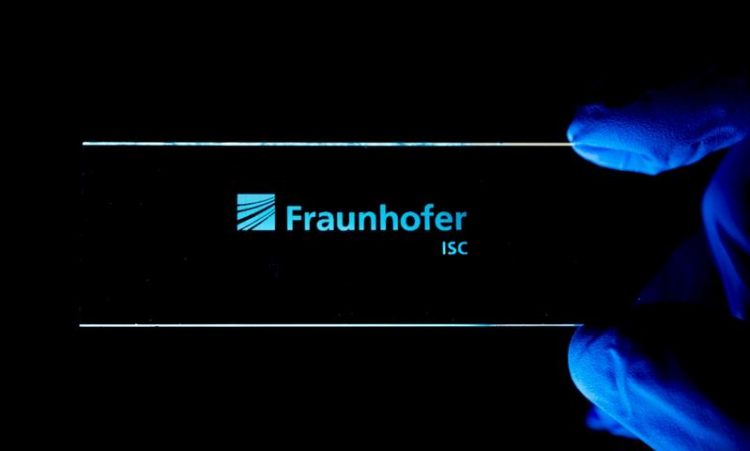Microoptics – A smarter and faster way to replicate complex freeform structures

Illuminating a structure consisting of 10.000 microprisms reveals the logo of Fraunhofer ISC. © K. Selsam-Geißler, Fraunhofer ISC
As of today, the fabrication of larger structures or larger batches of optical elements via 2PP takes too much time for an industrial scale production: 3D structures have to be processed point-by-point and only a single tiny focal volume of focused femtosecond laser pulses is used to solidify the material. To overcome this throughput bottleneck, the Fraunhofer ISC is currently investigating new approaches, methods and materials.
To accelerate the fabrication process Fraunhofer ISC applies nanoimprint techniques to replicate 2D or 2.5D structures for volume manufacturing. In this case, 2PP is used to create the “master“ structure from which a Silicone cast is molded. This mold is then used to replicate the master structure into either the same polymer as in the master structure or into other materials.
To test this approach, the Fraunhofer ISC has fabricated – among other tests – a complex array of 10.000 individual microprisms, with each a size of 60 µm. The fabrication of the entire prism pattern with a galvoscanner and dip-in lithography took several days. The copying of the master pattern took less than an hour.
To this effect, the Institute uses in-house synthesized inorganic-organic hybrid polymers of which the properties can be customized by chemical modification, formulation or even by the way of processing. In short, they can be particularly designed for 2PP applications and maintain their key properties (refractive index, low, absorption) even under harsh conditions. In addition, they offer superior optical properties, high stability and also biocompatibility.
Fraunhofer ISC develops hybrid polymers for various optical and microoptical applications according to customer requests. These materials can be adapted to particular processing methods and can be also molded with conventional techniques.
The smart combination of Two-Photon Polymerization with suitable methods of replication can provide both: true freeform 3D microstructures and a rapid and reliable fabrication technology for lot sizes larger than one. The technique also allows combining different forms like prisms, lenses, or pyramids in just one substrate. So, the fabrication of tailor-made geometries according to target specifications is possible. This paves the way to use 2PP for the industrial production of optical and microoptical elements.
In the future, Fraunhofer ISC will further optimize its materials and methods for the industry-relevant upscaling and replication of microoptical structures, in particular, of large area diffractive optical elements (DOE) that have yet remained a challenge.
Media Contact
All latest news from the category: Materials Sciences
Materials management deals with the research, development, manufacturing and processing of raw and industrial materials. Key aspects here are biological and medical issues, which play an increasingly important role in this field.
innovations-report offers in-depth articles related to the development and application of materials and the structure and properties of new materials.
Newest articles

Machine learning algorithm reveals long-theorized glass phase in crystal
Scientists have found evidence of an elusive, glassy phase of matter that emerges when a crystal’s perfect internal pattern is disrupted. X-ray technology and machine learning converge to shed light…

Mapping plant functional diversity from space
HKU ecologists revolutionize ecosystem monitoring with novel field-satellite integration. An international team of researchers, led by Professor Jin WU from the School of Biological Sciences at The University of Hong…

Inverters with constant full load capability
…enable an increase in the performance of electric drives. Overheating components significantly limit the performance of drivetrains in electric vehicles. Inverters in particular are subject to a high thermal load,…





















